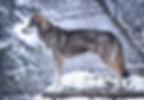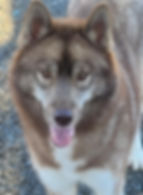Siberian Husky Genetics
The coat colors described here are informed by genetics and may be different from color descriptions by breed clubs.

Grey and White
Genotype: eA/- ky/ky aw/- B/-
A locus haplotype: VP2 HCP2




Grey and white is what we see when domino (eA) modifies the agouti phenotype by reducing black pigment and increasing the yellow/cream pigment. This color can come in many shades due to other genes causing variation in black (eumelanin) and yellow (pheomelanin) pigments. Greys that have low intensity pheomelanin and less eumelanin pigment are generally referred to as silver. Greys with higher intensity pheomelanin pigment are called wolf grey. This color generally has two or three bands due to pigment switching.
Agouti
Genotype: E/- ky/ky aw/- B/- or
Em/- ky/ky aw/- B/-
A locus haplotype: VP2 HCP2

Agouti is an ancestral phenotype and is the most common in modern grey wolves. This color is due to a combination of alleles at different genes that gives a banded coat. There are two genotype combinations that give this color in Siberians which are denoted above, however there are minor phenotypic differences between these genotypes resulting in variation in this color. The Em agouti has a heavy black mask around the nose and lips at minimum, but may extend to cover the eyes as well. Hairs can show anywhere from two to five+ bands with these genotypes. Note that a root band, or dark color along the base of the hair, does not need to be present for this color. Many factors can affect pigment switching on these genotypes such as age, diet, length of coat, season, health, etc.





Black and White
Genotype: eA/- ky/ky at/- B/-
A locus haplotype: VP2 HCP3-5




This color is similar to grey but the difference lies in one of three loss of function mutations in the hair cycle promoter of the ASIP gene. This causes more eumelanin pigment compared to a grey and less pheomelanin. These dogs generally have a black back with tan to white hair on cheeks, eyebrows, and back legs (aka tanpoint). The color may show anywhere from one to five different bands on a single hair. Expression of domino and other genes can decrease the amount of black pigment and increase yellow pigment resulting in a lighter back which is sometimes erroneously referred to as a "dilute black and white". Dilute has a different meaning in genetics so should not be used to describe any shade of this color.
KB Domino Agouti (no official name)
Genotype: eA/- KB/- aw/- B/-
A locus haplotype: VP2 HCP2
KB is an allele that causes increased expression of black pigment, sometimes referred to as dominant black, and usually makes a dog solid black. When combined with domino (eA), some pheomelanin pigment gets made and we see a color that is banded very similar to agouti, but the face markings are typically more sooty and less sharp in contrast. There is no official name for this color at this time, although most just refer to these dogs as agouti.








Red Agouti
Genotype: E/- ky/ky aw/- b/b
or Em/- ky/ky aw/- b/b or
eA/- Kb/- aw/- b/b
A locus haplotype: VP2 HCP2
A red agouti is the same as a black-based agouti, only the black pigment is now brown. Unless these dogs are DNA tested, it is difficult to differentiate KB domino agouti from E or Em agouti, and thus they are lumped together here.
Light Red and White
Genotype: eA/- ky/ky aw/- b/b
A locus haplotype: VP2 HCP2
Red is actually brown in Siberians. These dogs are the same as grey, just with black pigment replaced with brown.








Red and White
Genotype: eA/- ky/ky at/- b/b
A locus haplotype: VP2 HCP3-5
These dogs are sometimes referred to copper and white. They are the same as black and white with the pigment brown instead of black.
KB domino Tanpoint (no official name)
Genotype: eA/- KB/- at/- B/-
Tanpoint (no official name)
Genotype: E/- ky/ky at/- B/-
A locus haplotype: VP2 HCP3-5
Like KB domino agouti, this color does not have an official name. Many just call them black and white, but they are genotypically and phenotypically different. Similar to the KB domino agouti, the KB allele again is unable to make the dog completely black and we often see tanpoints on these dogs (that can range in color from tan to white) and sooty grey color on the face. These dogs look very similar to regular E-based tanpoints, and thus they are lumped together here. If combined with the Em allele instead of E, these dogs may appear solid black with a small amount of cream on legs.








Red KB Domino Tanpoint (no official name)
Genotype: eA/- KB/- at/- b/b
Red Tanpoint (no official name)
Genotype: E/- ky/ky at/- B/-
A locus haplotype: VP2 HCP3-5
These dogs are just like the black based version, but black pigment is now brown.
Solid Black or Seal
Genotype: E/- (or Em) KB/- B/-
Solid Red or Red Seal
Genotype: E/- (or Em) KB/ky at/- b/b
A locus haplotype: Any
When E or Em combines with KB, the KB allele increases the production of eumelanin pigment making a solid black or brown dog. Sometimes ASIP is able to interact with the pathway (specifically Ay or aw alleles) and cause a small amount of pheomelanin which results in a seal color, but the genetics of this are unknown at this time.




White
Genotype: e/e with B/- or b/b
A locus haplotype: Any




White is a result of a loss of function mutation at the MC1R gene, known as the E locus. When dogs have two copies of this mutation, they are unable to make black or brown pigment in the coat and only yellow pigment is produced which can range in color from a yellow-cream to pure white. There are currently two known mutations that occur in Siberians that can give this color: e1 and e3. Any combination of these two alleles will result in a white (or cream) dog. It is not uncommon for these dogs to have darker cream color on the body especially as puppies. The color of the nose is still controlled by the B locus, so B/- whites have black noses whereas those that are bb will have a brown nose.
A second genotype that can also produce a white dog is extreme piebald. Although this color is less common, it is easy to distinguish from an ee white by the color of the eye rims. Extreme piebald whites will have pink eye rims, whereas ee whites will have black or brown.
Piebald
Genotype: sp/sp with all colors
A locus haplotype: Any
The piebald phenotype is the result of a defect in pigment cell migration preventing pigmentation in the white spotted areas. All colors can theoretically come in piebald. The amount of white spotting appears to be additive with an increased number of causative mutations in this gene. Extreme white can result in an all white dog which is easily distinguished from an ee white which will have pigmentation on the eye rims. Note that since these mutations result in defective pigment cell migration, it is possibly the inner ear will not be pigmented. Dogs with a large amount of white spotting, especially on the head, may have congenital hereditary deafness if pigment cells are also absent from the inner ear. The prevalence varies by breed, and congenital sensorineural deafness has been reported in Siberians that have an excess of piebald white coat pigmentation. Importantly, unilateral hearing impairment is very difficult to detect in dogs without a BAER hearing test.




Sable
Genotype: E/- or eA/-, ky/ky, Ay/-, B/-
A locus haplotype: VP1 or VP2 HCP1




Sable is the result of a gain-of-function mutation in the ASIP gene, specifically in the hair cycle promoter (HCP1). This results in greater pheomelanin and less eumelanin production. Phenotypically these dogs have black tipping over a yellow coat in adulthood, but E background sables are generally born very dark and progressively lighten with age (note that the VP2 promoter will give slightly more black tipping [known as a shaded yellow sable] than VP1 [known as a dominant yellow sable] in adulthood). eA-background sables are born much lighter and look similar as an adult. It is not the intensity of the pheomelanin that defines a sable; rather, the increased amount of pheomelanin (decrease in eumelanin) is a defining characteristic of this color. The intensity of the pheomelanin is controlled by other genes and can range from red to white. Since most Siberians are ii at the Intensity locus, most sables are cream to white in color with black tipping, however an E, I- genotype has more intense red coloration. It can be difficult to distinguish E from eA in this color as an adult.
Saddleback
Genotype: E/- or eA/-, ky/ky, aw/- or at/-, B/- or b/b
A locus haplotype: VP1 HCP2-5
Black (or brown) saddleback is similar to tanpoint, however much of the eumelanin on the head and body recedes to the dorsal area as the dog ages leaving a saddleback pattern. This phenotype is due to the VP1 promoter combined with the same loss-of-function hair cycle promoters that produce tanpoint (HCP 3-5) at the ASIP gene. The same effect can be seen in agouti-based dogs (HCP2) when combined with VP1 so that much of the eumelanin recedes and the dog has a shaded saddleback pattern in the dorsal area.


